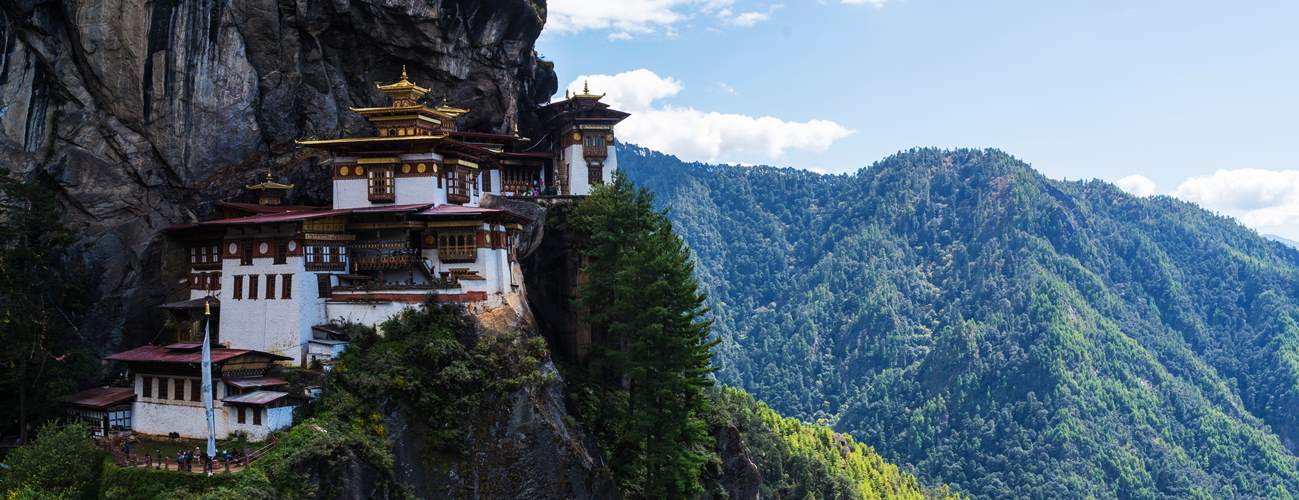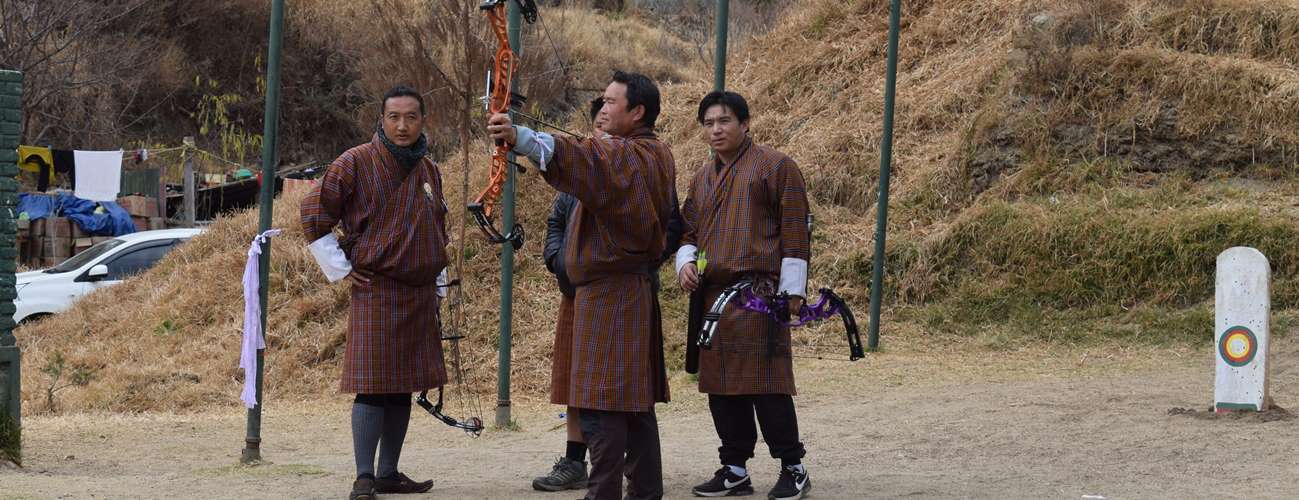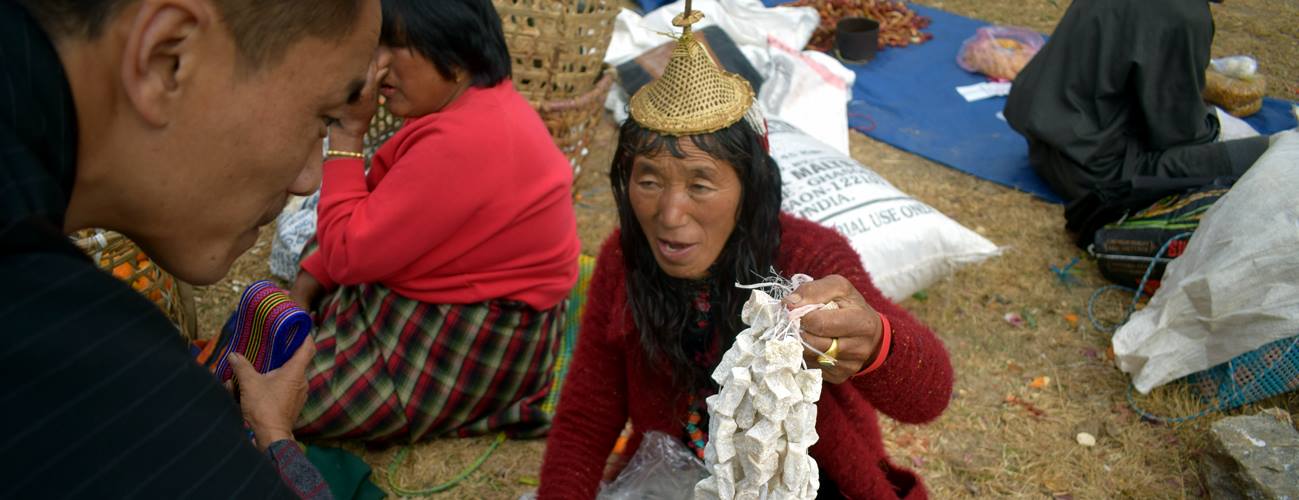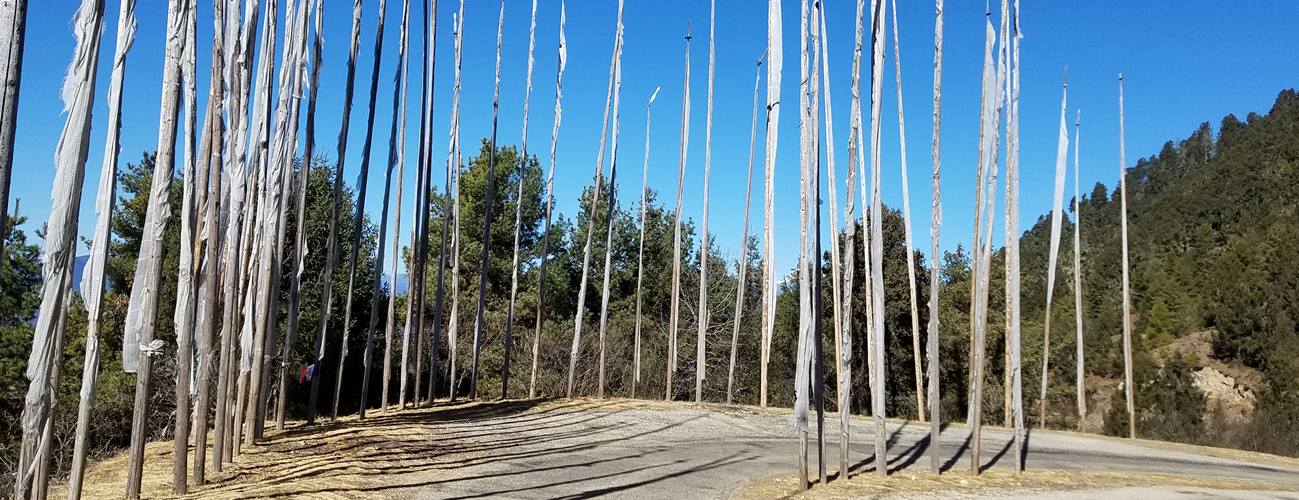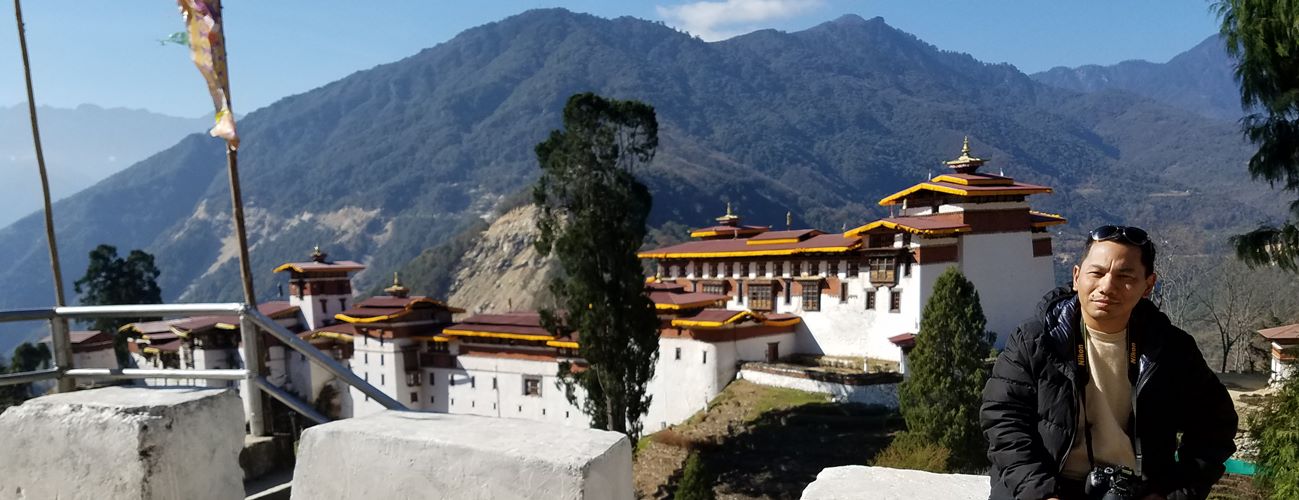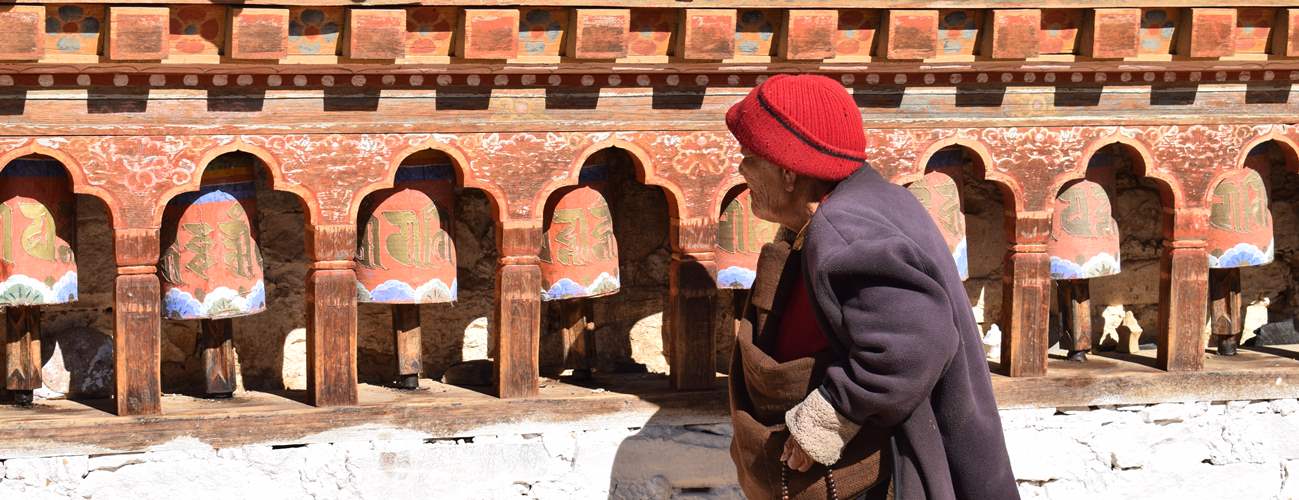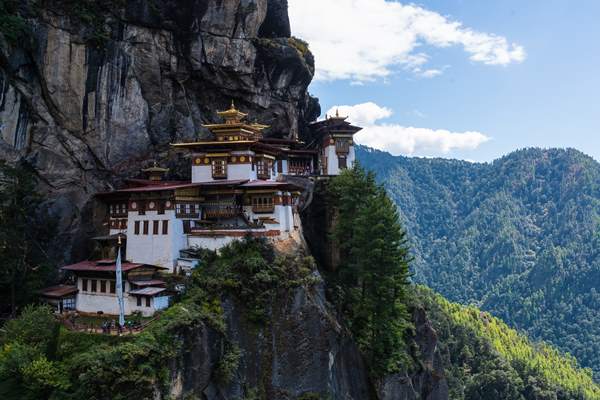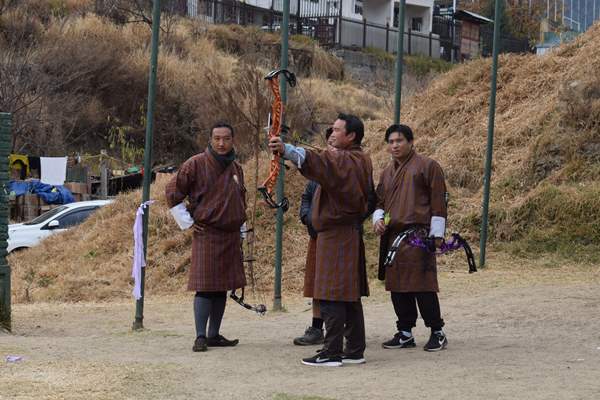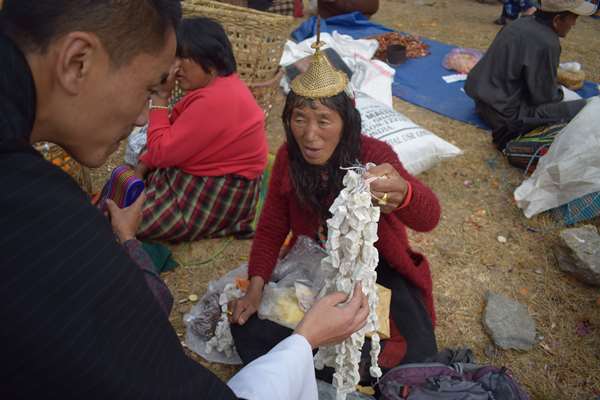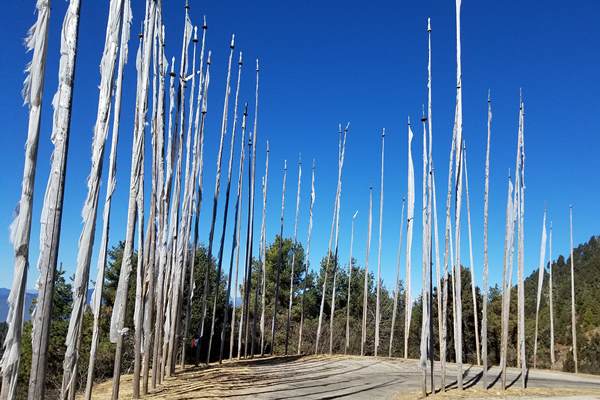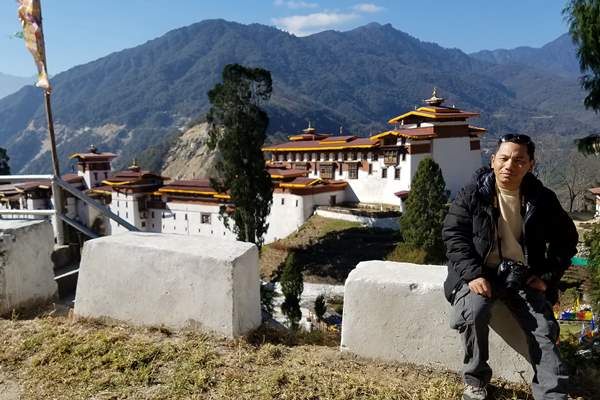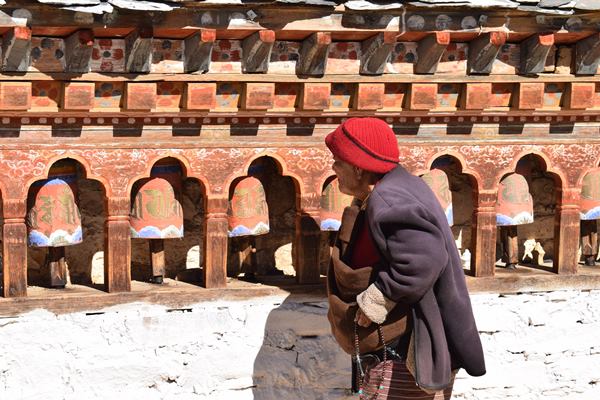Trip Overview
On this trip, we trek on the Nabji-Korphu trail in the Jigme Singye Wangchuck National Park, take safaris in Royal Manas National Park and survey the cultural heritage of Bhutan. Both Nabji KorphuTrail and the Manas National Park receive very few foreign travelers, and so these areas are mostly unexplored.
Difficulty Level: 3, off-road travel, light trekking
Rating: Discovery
Highest Altitude: 11,230 ft at Pele La Pass
Trip starts at: Paro, Bhutan
Trip ends at: Paro, Bhutan
Accommodations: Hotels and guesthouses
Places visited: Thimphu Phobjikha Trongsa Jangbi Kubdra Nabji Korphu Nimshong Panbang Gelephu Punakha Paro
Trip Cost ( Based on minimum 3-participants)
Sep, Oct, Nov, Mar, April, May & June:
US$ 3999 Per Person
Private Room Supplement:
US$ 650 Per Person
(Mandatory for a solo traveler)
Jul, Aug, Dec, Jan & Feb:
US$ 3599 Per Person
Private Room Supplement:
US$ 550 Per Person
(Mandatory for a solo traveler)
Airfares are not included.
Itineray
Day 01~Arrive in Paro, Bhutan
Flights to Paro (altitude 7,380 feet, or 2,250 meters) arrive from Kathmandu or Bangkok or Delhi. Please allow at least one night in those cities before and after your trip to ensure a safe connection with flights to and from Bhutan. Please arrange your international airfare to the gateway city; Far & High will book the onward flight for you. Your Bhutan visa is part of the tour. We will email it to you in advance, as you’ll need it at check-in for your flight to Bhutan and again upon arrival at the Paro airport, where your passport will get its final visa seal. After completing immigration and customs formalities, your guide and driver will meet you outside the terminal and transfer you to a restaurant in the town for lunch.After lunch, your guide will lead explorations of Paro. We begin from the National Museum housed at Ta Dzong, which served as a watchtower for the Rinpung Dzong (a dzong is a fortress and a religious and social center). The museum has a beautiful collection of books, murals, Bhutanese textiles, crafts, weapons, olden utensils, stuffed animals, and a rich philatelic collection. From here, we descend to Rinpung Dzong, which is the district headquarters and also the seat of the district's religious body.
Now, we proceed on an hour-long scenic drive to Thimphu with a stop for a short walk at the 13th-century temple of Tamchog Lakhang which was built by the famous Tibetan iron-bridge builder Thangthong Gyalpo – architect, physician, teacher, and a saint! The temple is owned and maintained by his descendants.
In Thimphu, we’ll have time to settle in and take some rest before a walking tour of the tiny city. Thimphu is probably the only capital in the world without any traffic lights! We will leisurely take a stroll and visit the memorial Chorten (shrine) of the 3rd King of Bhutan Jigme Dorje Wangchuk, and whatever else time and our interest allow.
Day 02~ Sightseeing and hiking in Thimphu
After breakfast, we are off for sightseeing and hiking. We have a lot to see today! Depending on your interest, pace and available time, we may or may not visit all the sights listed below.
We first visit the weekend
market of Thimphu, if we are here during the weekend. Farmers from the neighboring
villages come to sell
their fresh produce. We will also visit the archery field to see the national
sports of Bhutan.
Next, we can visit the National Institute Zorig Chusum that offers a six-year course on Bhutan's
traditional arts
and crafts, including painting, wood carving, embroidery, and statue making. Then we can head to
the Simply
Bhutan Museum resembles a typical Bhutanese village with demonstrations and
performances on Bhutan's
arts, culture, and lifestyle. Here, you can try Bhutanese costumes and pose for
photographs!
Next, we can visit the Takin Sanctuary. Takin – a kind of
sheep by way of antelope — are the National animals of Bhutan and believed to exist only in Bhutan
Himalaya. On the way back, stop at the Zilukha Nunnery in Drubthob Goemba, home to
40-60 Buddhist nuns.
We can visit the Gagyel Lhundrup Weaving Center, which
produces traditional hand-woven textiles and has a selection of cloth and ready-made garments for
sale. Here, you can see the local women working their looms.
Next, visit the
Changangkha Temple, one of the oldest in Thimphu, built in the 12th Century. The
temple houses Chenrizig (Avolokitesawara), an 11-headed, thousand-armed manifestation as the central
statue.
In the afternoon, we can visit the World’s Largest Buddha Image —
Buddha Dordenma, situated atop a hill overlooking the Thimphu Valley-the latest
addition to Thimphu's attractions. This massive 169 feet tall image has a three-story base that
houses a large chapel, while the body itself contains 125,000 smaller Buddha statues.
An option: Hiking enthusiasts keen to experience monastic lives away from
the crowds of town can take a half-day hike to Tango Goemba monastery-with a trade-off with some
sights listed above. Tango Goema Monastery is Bhutan's highest learning center for Buddhist studies.
All Je Khenpo, the religious head of Bhutan, must complete a nine-year program here, including a
three-year, three-month, three-day course in mediation at the nearby Cheri Goemba Monastery! With
luck, the monks will be in recess, and we can join them for tea. (Note: on a group tour, there must
be a unanimous decision to take this hike.)
Interested in the Buddhist astrology? On our way back, we can stop at Pangri Zampa Temple-an astrology school for the state clergy. More than a hundred monks study astrology in this center, and they welcome the public for astrology consultation if anyone is interested. A week-advance notice is requested for scheduling purpose, though.
Day 03~ A long day drive to Phobjikha Valley
(85 miles, 6 hours).
After an early breakfast, we leave for Phobjhikha Valley.
As we leave Thimphu behind, the road gradually winds up through villages and pine forests to Dochula Pass (3100m/10168 ft.), marked by 108 Buddhist shrines, flickering with sacred prayers flags offered by the Buddhist devotees. On a clear day, the pass provides a superb panorama of the snow-capped mountains and the valleys.
From the pass, the road drops slowly through the changing vegetation to the sub-tropical lowlands of the Punakha and Wangdue Valleys. In about 2 and a half hours, we will arrive in Punakha where we will stop for lunch.
We cross Lawala Pass and continue on the winding road down to the glacial valley of Phobjikha on the slopes of Black Mountains. Phobjikha is a glacial valley on the western slopes of the Black Mountains, bordering the Jigme Singye Wangchuck National t is one of the most important wildlife preserves of Bhutan as the large flock of black-necked cranes migrate here from Siberia, Mongolia and Tibet during the winter time. Usually, the first flock arrives in late October or early November. In addition to the cranes, there are also muntjacs (barking deer), wild boars, sambars, serows, Himalayan black bears, leopards and red foxes in the surrounding hills.
Today, we first visit the prominent Gangtey Gompa of the early 17th century. It is the only Nyingmapa monastery in the region. From here, we jump on the Gangtey Nature Trail for an about 2-hours easy hike through the pine forest and the valley. The walk ends over the meandering Chhu Nap ( Black River) near Khewang village where you are picked up by transport.
Upon arrival, check into your accommodation and the rest of the day is at leisure.
Day 04~ Explore Phobjika Valley
Phobjikha is a glacial valley on the western slopes of the Black Mountains, bordering the Jigme Singye Wangchuck National Park. It is one of the most important wildlife preserves of Bhutan as the large flock of black-necked cranes migrate here from Siberia, Mongolia and Tibet during the winter time. Usually, the first flock arrives in late October or early November.
In addition to the cranes, there are also muntjacs (barking deer), wild boars, sambars, serows, Himalayan black bears, leopards and red foxes in the surrounding hills.
After breakfast, one-hour or little longer drive brings us to the trailhead in Gogona village. Visit the local cheese factory and the beautiful temple. The cheese maker produces excellent fresh cheeses based on Swiss cheese making traditions. Maybe you want to purchase some cheese that you can eat along the way for energy The trail goes through rhododendron, magnolia, juniper and bamboo bushes, and if you are lucky, maybe you can spot some wildlife.
The trail back towards Phobjikha valley starts downwards through the small village and crosses the valley over a beautiful flower meadow. It then continues through mystifying forests up right before the Tshelela Pass where the landscape opens up. From the pass, you continue partly on the dirt road and party on beautiful forest paths downwards and into Phobjikha valley.
Day 05~Travel to Trongsa
(118 miles, 5 hours)
Early afternoon, we depart for Trongsa, 118 miles over four to five hours, as we backtrack to the main road and head to the east. The road gradually climbs the Black Mountain Range and crosses Pele-la pass (10,824 feet, or 3,300 meters) where the panoramic views include Mount Jhomolhari on the border with Tibet.
Below is Trongsa, the hometown of the present rulers of Bhutan. We stop briefly at the Chendebji chorten, a large white monument, which is said to have concealed the remnants of an evil spirit that was vanquished here.
Re-energized after lunch, visit the majestic Trongsa Dzong that must have captivated your attention already. The Dzong is the former capital and ancestral home of Bhutan's monarchy. An architectural wonder in itself, the fortress currently serves as the headquarter of Trongsa district and a monastery.
Day 06~Travel back to Shigatse
4980m/16,600 ft., 90km/56miles, 3-4 hrs.
Enjoy the spectacular views of Mount Everest and other majestic peaks of the Himalaya! If you didn't
visit the base camp, you have a chance this morning, and usually, you have better and unobstructed
views in the morning.
After breakfast, retrace drive to the main highway and continue on a long journey to Shigatse.
Overnight: Shigatse Gesar Hotel
Meals : Breakfast
Day 07~Travel back to Lhasa.
For the return trip back to Lhasa, we take the Northern Friendship Highway that follows the
Yarlungdzangbo River.
Check-in hotel and balance of the day is free for you to take rest or take a stroll in the town.
Overnight: Dekhang Hotel
Meals : Breakfast
Day 08~Departure.
After breakfast, get transferred to the airport in time for the flight to your next destination. Meals : Breakfast
Trip Info
Trip Includes
- Tibet entry permit.
- Accommodation on double occupancy basis.
- Daily Breakfast at your hotel
- All transfers and sightseeing by a private air-conditioned van or minibus.
- Sightseeing admission fees.
- English speaking local certified Guide.
Trip Does Not Include
- International and internal airfare.
- Airport Taxes.
- Chinese visa fee.
- Lunch and dinner.
- Drinks, tipping, laundry, phone, internet, and other personal expenses.
- Travel & Health Insurance.
- All extra costs due to nature or unforeseen events.
- Excess baggage charges.
Passport and visa
The remaining validity of your passport must be a minimum of six months beyond your return date. And please make sure you have two blank visa pages for China only.You will need to apply for a Chinese visa at your nearest Chinese embassy. We will help you with the form and necessary supporting documents. Please, initiate the application process in a minimum of three months before the travel date. We need a copy of your Chinese visa forty-five days before the planned arrival date in China. We will obtain the Tibetan Entry permit for you and ship it to your hotel in the gateway city (Chengdu or Beijing). You need to present this document when you check-in for the flight to Lhasa. Your Guide will be holding all other necessary permits required for this trip.
Accommodation & meals
In Lhasa, we will book a mid-range tourist standard hotel in Barkhor Area. Our choices of hotels are
Dhekhang, Kyichu,
or Gorkha Hotel, located in the old Tibetan quarter of Lhasa. These are locally managed mid-size
properties with an
adequate comfort level. There are a few four stars and 5-star hotels such as 4-Points By Sheraton,
Shangrila Hotel,
St. Regis, etc. and we can book them for you on an additional cost. In Shigatse also, we book a
local three-star hotel.
Accommodation in Rongbuk is rudimentary. The toilet is a Tibetan style squat with no running water.
There is no shower
here. Hotels in Tibet provide limited supplies of toiletries, and so, please bring your own set.
They may not also have a
hairdryer, iron, and ironing boards. If the preferred hotels listed in the program are not
available, we will book the
next best possible property in that price category.
Most hotels in Lhasa and Shigatse provide with WiFi, but some hotels may charge some nominal fee for
using the WiFi.
Food
The trip cost includes breakfast only. The hotels serve Chinese, Tibetan, Indian, Nepali, and
western-style breakfasts.
The trip does not include lunch and dinner and so budget $10-12 for a meal. You may want to bring
some dry fruits, chocolates,
energy bars, vitamin supplements, etc.
Roads and Transportation
Now the road in Tibet is in good condition! They are all paved through the basecamp. However, vehicles have to stop at Rongbuk Monastery- the last point you can get by car. Depending on the final group size, we use a minivan or coaster bus all transfers and tours. Bring a protection mask for your nose to avoid inhaling dust! The driver may or may not speak English, but he knows the Tibetan roads and will be an experienced one.
Tour Guide
You will be accompanied by experienced and knowledgeable English speaking Tibetan Guide who you meet on arrival at Lhasa airport. Besides guiding you on tour, your guide will also be responsible for dealing with check posts, and local bureaucracies and complete necessary paperwork. Guide and driver are different persons.
Altitude sickness and Health Issues
There are no mandatory vaccinations required for traveling to China and Tibet unless you have visited any yellow fever affected areas in the last six months. However, you may consider protection against rabies Hep A, Typhoid, etc. Travelers with cardiac-pulmonary issues or any other medical conditions are recommended to consult their physician. The primary health consideration in Tibet is altitude-related illness or Acute Mountain Sickness (AMS). You may experience some mild symptoms initially, such as headache, lethargy, nausea, and sleeplessness, but these should lessen within a few days. Although the trip doesn't expect you to be athletic, you will be glad if you are fit. So, please, start some physical exercises like jogging, swimming, cycling, hiking, etc. about several weeks before the trip.
Booking and cancellation
We request a deposit of US$300 along with a completed trip application form and passport copies. If you need us to book the airfare to Lhasa, we will give you the quote. The final payment is due 90 days before the trip date. Balance payment on credit card attracts an additional 3.5% fee.
Cancellation fees
- Ninety days prior departure: Administrative fee US$ 150 per person.
- Sixty-Eighty-nine day's prior departure: US$ 250 or 25% of the land cost whichever is higher.
- Forty-five days to Fifty-nine days prior departure: US$ 450 or 50% of the land cost whichever is higher.
- Thirty days to Forty-four days before departure: US$ 600 or 75% of the land cost whichever is higher.
- Less than Thirty days: 100%,
